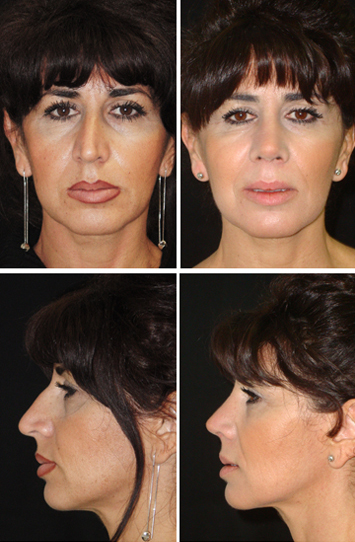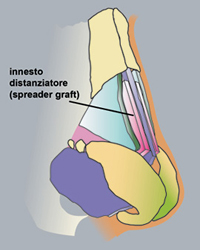

The dorsal hump "stretches" the nose upwards, tightening it. As well as giving an unpleasant appearance, it also creates respiration difficulty. This situation is called "tension nose". Right: after rhinoseptoplasty with insertion of "spreader graft" .

Spreader graft
I have difficulty breathing because my nose is narrow.
Sometimes respiration difficulty is caused by a condition called "incompetence or collapse of the inner nasal valve". This situation occurs essentially in two cases:
1 - When the bridge of the nose is very narrow congenitally. Often it is associated with a pronounced hump which, "stretching" the nose upwards, tightens it.
2 - When the bridge of the nose is narrow and is later weakened due to trauma or a surgical procedure. In both cases during inhalation (when air enters the nose), the walls of the nose tend to close as if sucked inwards from the passage of the air.
Often this phenomenon is accentuated during forced inhalation (when you try to breathe in fast and/or deeply like during a race or physical exertion). Moreover it is frequently joined by another type of anomaly of the nose called "insufficiency of the external nasal valve". Many people, who suffer from these problems, including some athletes, use external nasal dilation plasters that are particularly effective in these cases.
Others stretch the skin of the cheeks outward with their hands enlarging the nostrils a little in order to breathe more easily. Some have already been operated on the nasal septum but have not resolved their problem since the cause is not deviation of the septum or partial deviation, but rather a nasal valve insufficiency.
What can be done?
The insufficiency of the inner nasal valve can be corrected with surgery that, through the use of cartilage grafts from the patient, enlarges (when they are too narrow) and hardens the walls of the nose. These grafts spacers (spreader graft) were introduced in 1983 by the Californian surgeon Jack Sheen and are used today by the most expert nasal surgeons.
Not only can they serve to improve respiration, but in many cases they also have an aesthetic function since they give the nose, when necessary, a softer and more attractive line.
Rhinomanometry, rhinometry and nasal endoscopy are the tests necessary to study these irregularities and to evaluate surgical possibilities.